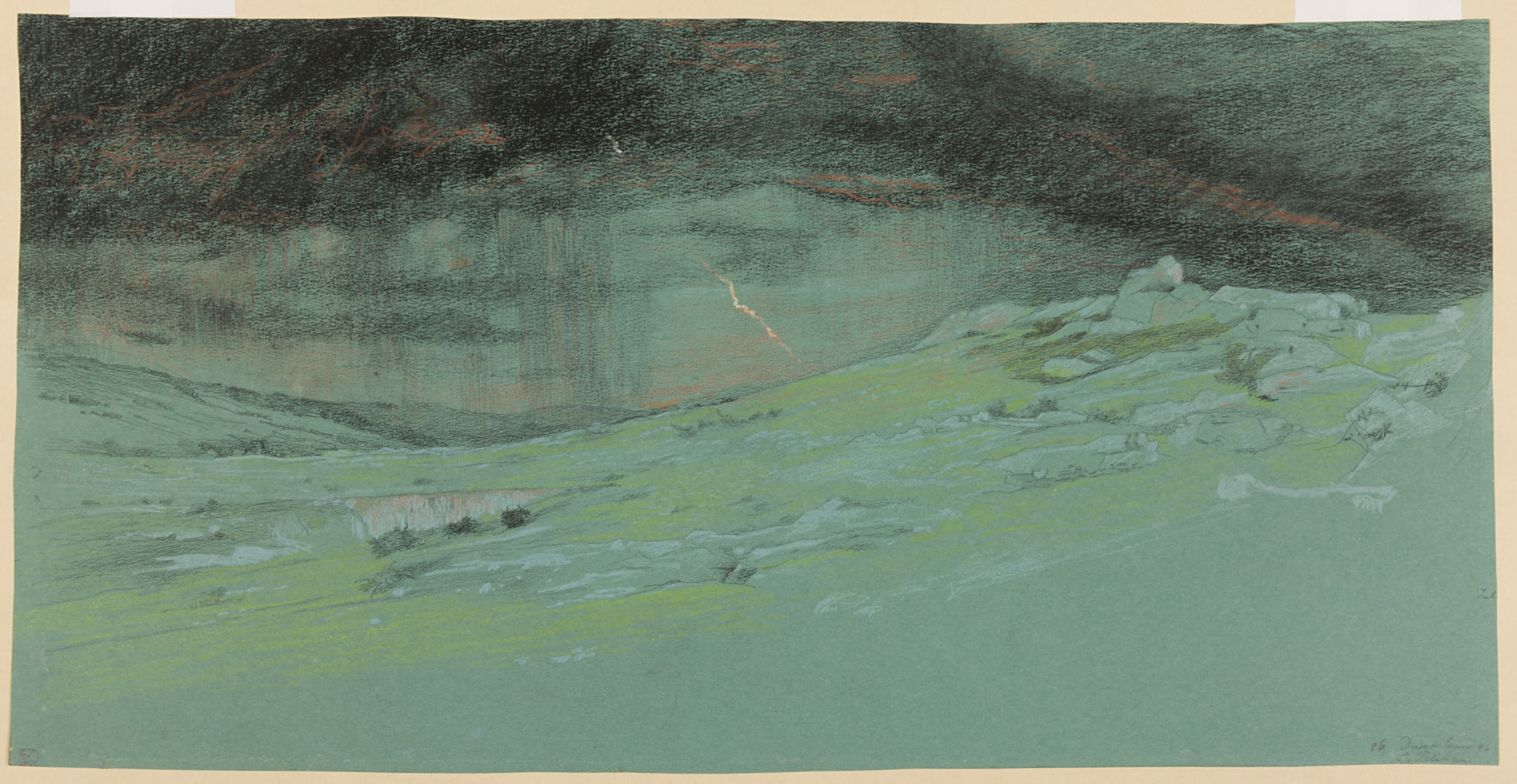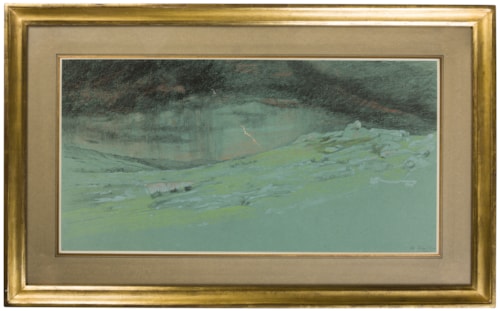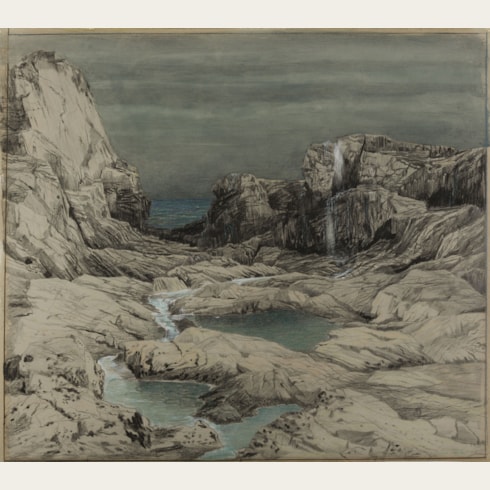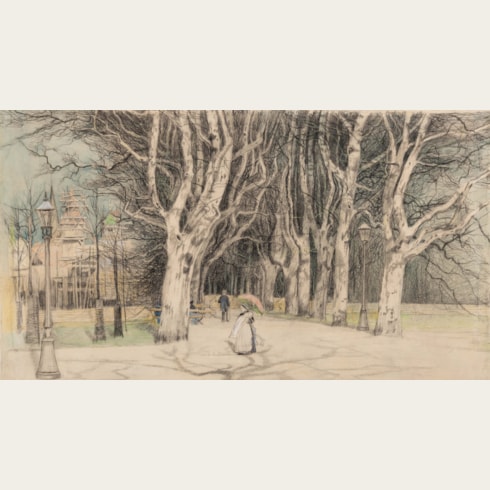Emilie MEDIZ-PELIKAN
(Vöcklabruck 1861 - Dresden 1908)
Landscape with a Thunderstorm
Sold
Pencil, charcoal and pastel on blue-green paper.
Signed, dated and inscribed 96 Duino Surnal(?) 96 / E. Pelikan at the lower right.
Inscribed Juli-(?) [cut off] at the right centre edge, and numbered 7 at the lower left.
Titled and dated “gewitter” 1896 and numbered 165 on the verso.
289 x 579 mm. (11 3/8 x 22 3/4 in.)
Signed, dated and inscribed 96 Duino Surnal(?) 96 / E. Pelikan at the lower right.
Inscribed Juli-(?) [cut off] at the right centre edge, and numbered 7 at the lower left.
Titled and dated “gewitter” 1896 and numbered 165 on the verso.
289 x 579 mm. (11 3/8 x 22 3/4 in.)
The present sheet was drawn near the ancient fishing village of Duino, on the coast of the northern Adriatic Sea, northwest of Trieste in the Italian province of Friuli-Venezia Giulia. Emilie Mediz-Pelikan first visited the town, at the time a fashionable seaside resort on the Austrian Riviera, in 1891, the year of her wedding to Karl Mediz. She returned there in 1896, when this drawing was made, and again 1898 and 1905. She painted and drew several views of the beach and shore near the picturesque village, below the cliffs dominated by Duino Castle overooking the Gulf of Trieste. After the end of the First World War and the demise of the Austro-Hungarian Empire, Duino became part of the Kingdom of Italy.
A stylistically comparable chalk drawing by Emilie Mediz-Pelikan - a seascape dated 1905 and also on blue-green paper - is among a group of seventeen sheets by the artist today in the collection of the Albertina in Vienna. Another group of some fifteen drawings by Mediz-Pelikan is in the Kupferstich-Kabinett in Dresden, while six drawings by her are in the Jack Daulton Collection in California.
A stylistically comparable chalk drawing by Emilie Mediz-Pelikan - a seascape dated 1905 and also on blue-green paper - is among a group of seventeen sheets by the artist today in the collection of the Albertina in Vienna. Another group of some fifteen drawings by Mediz-Pelikan is in the Kupferstich-Kabinett in Dresden, while six drawings by her are in the Jack Daulton Collection in California.
Born in Upper Austria, Emilie Pelikan studied in Vienna with the landscape painter Albert Zimmerman, whom she accompanied to Munich in 1885, and her early landscapes are very much in the traditional style of her teacher. After Zimmerman’s death in 1888 she went to live in the artists’ colony in Dachau - where she first met the younger Viennese painter Karl Mediz - and also spent some time in Paris, studying the work of the Impressionist painters. By 1890, the year of her first gallery exhibition, Pelikan was working in the coastal town of Knokke in Belgium, where she again encountered Mediz. The two artists were married in Vienna in 1891 and spent a brief period in Krems an der Donau, where their daughter Gertrude was born. Finding little success in Austria, they eventually settled in Dresden in 1894.
Emilie Mediz-Pelikan worked closely alongside her husband, with whom she made regular sketching trips to the Tyrol and South Tyrol, Northern Italy and the Adriatic coast. In one of the only contemporary accounts of their work to be published in English, the British-Austrian art historian Amelia Sarah Levetus, who must have known the couple, wrote that ‘These two artists are man and wife; they have wandered in many places together, over the highest mountains and across glaciers, on the banks of deep rivers and on their pilgrimages have painted scenery and portraits and everything else between. They have endured the greatest hardships together and have worked together; they have chosen the same subjects for their canvases, yet their individualities remain, and in similar subjcets also there is a great variety of treatment...Frau Mediz-Pelikan also has immense energy, combined with poetry of expression more delicate than that of her husband; she loves to paint lavenders and silver greys, to bring out the very depths of that which she is depicting.’
Both Emilie Mediz-Pelikan and Karl Mediz were invited to participate in the inaugural Vienna Secession exhibition of 1898, at which they each showed three paintings. Emilie’s reputation as a gifted landscape painter and watercolourist was soon established, with her work much praised by critics and colleagues. While her youthful paintings had been in an Impressionistic manner, her mature landscapes reflect a particularly distinctive Symbolist quality. As one recent scholar has noted, ‘Emilie Mediz-Pelikan focused on the overwhelming power of nature, which she captured in the detailed and intensely colored brushwork of her mountain and Mediterranean landscapes, producing pictures that seem to flicker and oscillate.’ She was likewise a gifted portraitist, usually in the form of pencil or chalk drawings, and also illustrated Ricarda Huth’s novel Aus der Triumphgasse: Lebenskizzen, which was published in 1902.
In 1901 Mediz-Pelikan’s work was included in the Internationale Kunstausstellung in Dresden, and two years later a joint exhibition of works by Karl Mediz and Emilie Mediz-Pelikan, including twenty-four paintings and sixteen drawings by the latter, was held at the Hagenbund, the Austrian artist’s association in Vienna. At the February 1903 exhibition her painting of Blossoming Chestnut Trees was acquired by the state for the newly-established Moderne Galerie at the Lower Belvedere in Vienna, which opened to the public three months later. (Mediz-Pelikan was eventually made an honorary member of the Hagenbund, which did not formally accept women until 1924.) In 1904 an exhibition of Emilie’s graphic work took place at a gallery in Dresden, and in 1905 and 1906 her paintings were shown at the Künstlerhaus in Berlin.
As Amelia Levetus, writing in 1905, noted of Emilie Mediz-Pelikan and Karl Mediz, ‘In personal appearance these two are as different as their works; in nature they are one; he considers her the greater artst and she him…Both Herr and Frau Mediz look for new ground and out-of-the-way corners for work. They are both so fond of rich colouring that they seek those parts of the earth where Nature is most profuse in her gifts. They have both endured the blaze of the sun on the highest points of the Dolomites and other ranges of the South Tyrolean mountains, often spending days on their heights, at different periods of the year, with no one near, and sleeping under the blue canopy of heaven. In their open-air existence they have learned the true shades of the rays of the sun as they fall upon earth; and so they know full well all the tones from orange to violet, and from violet to orange...Both husband and wife are fond of their combinations of colours, greens, reds and greys...Of the two, Frau Mediz has the wider field. She has more tones and nuances, more delicacy and more variety…She is influenced by him, and also has nocturnes in blue and silver, such as Whistler might have painted…These two, both husband and wife, have a great future before them.’
Sadly, however, this was not to be. Emilie Mediz-Pelikan died suddenly of a heart attack in 1908, at the age of forty-seven. Her husband was devastated by the loss, and became something of a recluse, creating mainly graphic works and only a few paintings. His career never recovered before his death thirty-eight years later, in 1945. Although the estate of both Emilie Mediz-Pelikan and Karl Mediz was administered by the Staatliche Kunstsammlungen in Dresden, the couple’s daughter Gertrude refused to allow any exhibitions of their work to take place. The estates passed into the ownership of the East German state, and both artists fell into obscurity. Mediz-Pelikan’s paintings and drawings were eventually returned to Austria, and much of the estate was acquired by the Viennese art dealer Kurt Kalb. Although a small exhibition of her work was held in Linz in 1986, it has only been in the past two decades that Mediz-Pelikan’s oeuvre has been truly rediscovered and her posthumous reputation as a gifted landscape artist and draughtsman secured. In 2019 Emilie Mediz-Pelikan was among the artists included in the revelatory exhibition City of Women: Female Artists in Vienna 1900-1938, at the Österreichische Galerie Belvedere in Vienna, which today owns four paintings by the artist. Some seventeen drawings by Mediz-Pelikan are in the collection of the Albertina in Vienna, while another group of fifteen sheets is in the Kupferstich-Kabinett in Dresden. Six further drawings by the artist are in the Jack Daulton Collection in California, while a large pastel landscape of 1896 has recently been acquired by the J. Paul Getty Museum in Los Angeles. Other drawings by Mediz-Pelikan have recently been acquired by the Metropolitan Museum of Art in New York, the Art Institute of Chicago and the Museum of Art of the Rhode Island School of Design in Providence Rhode Island.
Emilie Mediz-Pelikan worked closely alongside her husband, with whom she made regular sketching trips to the Tyrol and South Tyrol, Northern Italy and the Adriatic coast. In one of the only contemporary accounts of their work to be published in English, the British-Austrian art historian Amelia Sarah Levetus, who must have known the couple, wrote that ‘These two artists are man and wife; they have wandered in many places together, over the highest mountains and across glaciers, on the banks of deep rivers and on their pilgrimages have painted scenery and portraits and everything else between. They have endured the greatest hardships together and have worked together; they have chosen the same subjects for their canvases, yet their individualities remain, and in similar subjcets also there is a great variety of treatment...Frau Mediz-Pelikan also has immense energy, combined with poetry of expression more delicate than that of her husband; she loves to paint lavenders and silver greys, to bring out the very depths of that which she is depicting.’
Both Emilie Mediz-Pelikan and Karl Mediz were invited to participate in the inaugural Vienna Secession exhibition of 1898, at which they each showed three paintings. Emilie’s reputation as a gifted landscape painter and watercolourist was soon established, with her work much praised by critics and colleagues. While her youthful paintings had been in an Impressionistic manner, her mature landscapes reflect a particularly distinctive Symbolist quality. As one recent scholar has noted, ‘Emilie Mediz-Pelikan focused on the overwhelming power of nature, which she captured in the detailed and intensely colored brushwork of her mountain and Mediterranean landscapes, producing pictures that seem to flicker and oscillate.’ She was likewise a gifted portraitist, usually in the form of pencil or chalk drawings, and also illustrated Ricarda Huth’s novel Aus der Triumphgasse: Lebenskizzen, which was published in 1902.
In 1901 Mediz-Pelikan’s work was included in the Internationale Kunstausstellung in Dresden, and two years later a joint exhibition of works by Karl Mediz and Emilie Mediz-Pelikan, including twenty-four paintings and sixteen drawings by the latter, was held at the Hagenbund, the Austrian artist’s association in Vienna. At the February 1903 exhibition her painting of Blossoming Chestnut Trees was acquired by the state for the newly-established Moderne Galerie at the Lower Belvedere in Vienna, which opened to the public three months later. (Mediz-Pelikan was eventually made an honorary member of the Hagenbund, which did not formally accept women until 1924.) In 1904 an exhibition of Emilie’s graphic work took place at a gallery in Dresden, and in 1905 and 1906 her paintings were shown at the Künstlerhaus in Berlin.
As Amelia Levetus, writing in 1905, noted of Emilie Mediz-Pelikan and Karl Mediz, ‘In personal appearance these two are as different as their works; in nature they are one; he considers her the greater artst and she him…Both Herr and Frau Mediz look for new ground and out-of-the-way corners for work. They are both so fond of rich colouring that they seek those parts of the earth where Nature is most profuse in her gifts. They have both endured the blaze of the sun on the highest points of the Dolomites and other ranges of the South Tyrolean mountains, often spending days on their heights, at different periods of the year, with no one near, and sleeping under the blue canopy of heaven. In their open-air existence they have learned the true shades of the rays of the sun as they fall upon earth; and so they know full well all the tones from orange to violet, and from violet to orange...Both husband and wife are fond of their combinations of colours, greens, reds and greys...Of the two, Frau Mediz has the wider field. She has more tones and nuances, more delicacy and more variety…She is influenced by him, and also has nocturnes in blue and silver, such as Whistler might have painted…These two, both husband and wife, have a great future before them.’
Sadly, however, this was not to be. Emilie Mediz-Pelikan died suddenly of a heart attack in 1908, at the age of forty-seven. Her husband was devastated by the loss, and became something of a recluse, creating mainly graphic works and only a few paintings. His career never recovered before his death thirty-eight years later, in 1945. Although the estate of both Emilie Mediz-Pelikan and Karl Mediz was administered by the Staatliche Kunstsammlungen in Dresden, the couple’s daughter Gertrude refused to allow any exhibitions of their work to take place. The estates passed into the ownership of the East German state, and both artists fell into obscurity. Mediz-Pelikan’s paintings and drawings were eventually returned to Austria, and much of the estate was acquired by the Viennese art dealer Kurt Kalb. Although a small exhibition of her work was held in Linz in 1986, it has only been in the past two decades that Mediz-Pelikan’s oeuvre has been truly rediscovered and her posthumous reputation as a gifted landscape artist and draughtsman secured. In 2019 Emilie Mediz-Pelikan was among the artists included in the revelatory exhibition City of Women: Female Artists in Vienna 1900-1938, at the Österreichische Galerie Belvedere in Vienna, which today owns four paintings by the artist. Some seventeen drawings by Mediz-Pelikan are in the collection of the Albertina in Vienna, while another group of fifteen sheets is in the Kupferstich-Kabinett in Dresden. Six further drawings by the artist are in the Jack Daulton Collection in California, while a large pastel landscape of 1896 has recently been acquired by the J. Paul Getty Museum in Los Angeles. Other drawings by Mediz-Pelikan have recently been acquired by the Metropolitan Museum of Art in New York, the Art Institute of Chicago and the Museum of Art of the Rhode Island School of Design in Providence Rhode Island.
Provenance
The estate of Karl Mediz and Emilie Mediz-Pelikan, Dresden
By descent to their daughter, Gertrude Honzatko-Mediz, Zurich
Probably Kurt Kalb, Vienna
Richard Nagy, London
Matthew Rutenberg, New York.
By descent to their daughter, Gertrude Honzatko-Mediz, Zurich
Probably Kurt Kalb, Vienna
Richard Nagy, London
Matthew Rutenberg, New York.







